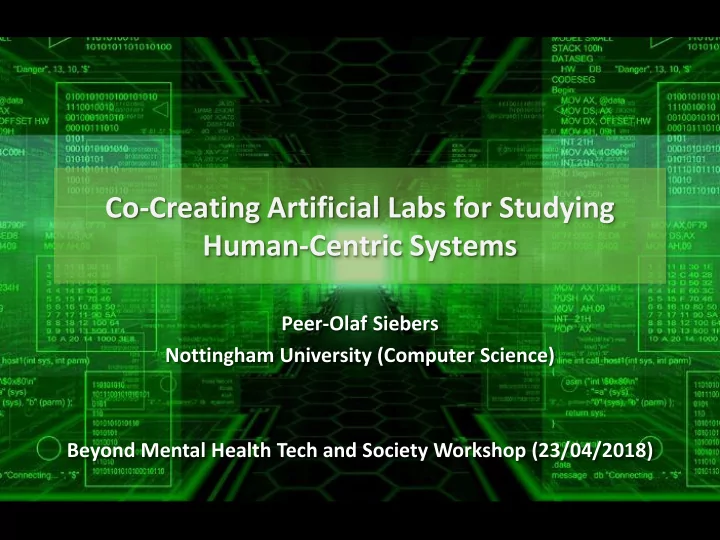

Co-Creating Artificial Labs for Studying Human-Centric Systems Peer-Olaf Siebers Nottingham University (Computer Science) Beyond Mental Health Tech and Society Workshop (23/04/2018)
What is this all about? • Social Simulation (formal definition) – Studies socio-economic phenomena by investigating the social macrostructures and observable regularities generated by the behaviour and relationships between individual social agents , and between agents and the environment in which they act. • Example from the Gaming World (https://www.youtube.com/watch?v=dcDy1CCd-F8) 2
Engineering Agent-Based Social Simulations • Agent-Based Modelling: – A complex system is represented by a collection of agents that are programmed to follow some behaviour rules – System properties emerge from its constituent agent interactions • How do we develop such Agent-Based Models (ABMs)? – There is a need for an ABM development framework • To support multi disciplinary collaboration • To work with all kinds of stakeholders (academics / non academics) • For exploratory and explanatory studies • For communication; conceptual modelling; reverse engineering 3
Engineering ABSS • What do we mean by "agents"? – Agents are "objects with attitude" (Bradshaw 1997) – Similar to non-player characters in computer games • Properties (borrowing from AI): – Discrete entities • Have a memory • Have their own goals (missions) • Have their own thread of control – Autonomous decisions • Capable to adapt and to modify their behaviour – Proactive behaviour • Actions depending on motivations generated from their internal state 4
Engineering ABSS • Model development process Inspired by Siebers and Klügl (2017) 5
Engineering ABSS • Using a focus group approach (group sizes of 4-5 work best) – Socrates vs Confucius • Collaborative brainstorming • Information capturing • Debates only when needed – Moderators • Will guide • Will act as stakeholder (modeller) – Iterative process • Reuse of information (small printed remarks are meant to guide the moderator) • Important to go forward and backwards 6
Illustrative Example Adaptive Architecture
Illustrative Example: Context • Context – The purpose of the study is to explore adaptive architecture design in the context of a novel museum visit experience , in particular the idea of having a large screen with a set of intelligently adaptive moving content windows that adapt position and size in response to movement and grouping of people in front of them. • Note about the difference between "actors" and "agents" – Actors represent specific roles individuals play – Agents represent individuals or groups of individuals – Throughout the modelling process we will convert actors to agents • Some differences can be embedded into archetypes 8
Engineering ABSS • Model development process Inspired by Siebers and Klügl (2017) 9
Illustrative Example: Analysis • Aim – Study the impact of an adaptive screen (including several display windows) in a museum exhibition room • Objectives – Study the interaction of "artificial intelligent" windows and visitors' movement; use the model to demonstrate to architects the idea of adaptive screens (artificial intelligent windows) • Hypotheses – A larger window size has a positive effect on visitor engagement – Space availability has a positive effect on visitor engagement – Screens with artificial intelligent windows attract viewers for longer 10
Illustrative Example: Analysis • Simulation Setup Opportunities (look at objectives/hypotheses to work these out) – A subset of parameters of the underlying theoretical movement model – Visitors arrival rate – Initial number of windows • Simulation Outputs (look at objectives/hypotheses to work these out) – Number of groups of visitors – Average time spend in the museum – Visual representation of the system and its dynamics 11
Illustrative Example: Analysis • Scope (what elements do we need to fulfil the aim) (look for nouns in previous text to find elements) 12
Illustrative Example: Analysis • The "social force model" (Helbing and Molnar 1995) assumes that the acceleration, deceleration and directional changes of pedestrians can be approximated by a sum of different forces, each capturing a different desire or interaction effect. • The "extended social force model" (Xie et al 2010) adds vision 13
Illustrative Example: Analysis • Key activities (actors come from scope table; use cases come from hypotheses and by creating user stories) As <actor>, I want to <what?> (so that <why?>) 14
Engineering ABSS • Model development process Inspired by Siebers and Klügl (2017) 15
Illustrative Example: Design • Archetype stencils – Allowing to define behaviour of actors 16
Illustrative Example: Design • Agent and object stencils (attributes can be derived from archetype criteria, theory parameters, methods can be derived from the states in the related state charts) 17
Illustrative Example: Design • State chart of visitor agent (states can often be derived from use cases) • Transition table of visitor agent 18
Engineering ABSS • Model development process Inspired by Siebers and Klügl (2017) 19
Illustrative Example: Design • Interaction (all elements defined in the agent/object stencil step need to be listed on the horizontal axis) (use cases could be listed on the vertical axis) 20
Illustrative Example: Design • Artificial Lab (attributes provide storage for all agents/objects and initialisation parameters required for experimental factors; methods related to responses) 21
Illustrative Example: Outcome • The resulting model 22
References • Bradshaw (1997). Software Agents. MIT Press. • Siebers and Klügl (2017). What Software Engineering has to offer to Agent- Based Social Simulation. In: Edmonds and Meyer (eds). Simulating social complexity: A handbook - 2e, Springer. 23
Socrates vs Confucius • Remember ... 24
Recommend
More recommend